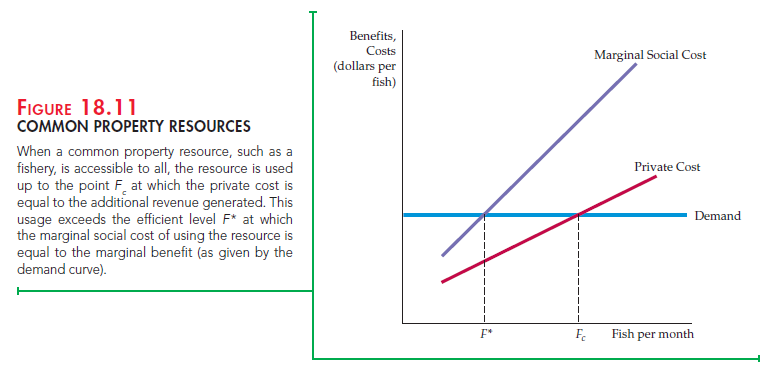Occasionally externalities arise when resources can be used without payment. Common property resources are those to which anyone has free access. As a result, they are likely to be overutilized. Air and water are the two most com- mon examples. Others include fish, animal populations, mineral exploration, and extraction. Let’s look at some of the inefficiencies that can occur when resources are common property rather than privately owned.
Consider a large lake with trout to which an unlimited number of fishermen have access. Each fisherman fishes up to the point at which the marginal revenue from fishing (or the marginal value, if fishing is for sport instead of profit) is equal to the cost. But the lake is a common property resource, and no fisherman has the incentive to take into account how his fishing affects the opportunities of others. As a result, the fisherman’s private cost understates the true cost to society because more fishing reduces the stock of fish, making less available for others. This leads to an inefficiency—too many fish are caught.
Figure 18.11 illustrates this situation. Suppose that because the catch is sufficiently small relative to demand, fishermen take the price of fish as given. Suppose also that someone can control the number of fishermen with access to the lake. The efficient level of fish per month F* is determined at the point at which the marginal benefit from fish caught is equal to the marginal social cost. The marginal benefit is the price taken from the demand curve. The marginal social cost shown in the diagram includes not only the private operating costs but also the social cost of depleting the stock of fish.
Now compare the efficient outcome with what happens when the lake is common property. In this case, the marginal external costs are not taken into account, and each fisherman fishes until there is no longer any profit to be made. When only F* fish are caught, the revenue from fishing is greater than the cost, and there is a profit to be earned by fishing more. Entry into the fishing business occurs until the point at which the price is equal to the marginal cost, point Fc in Figure 18.11. At F, however, too many fish will be caught.
There is a relatively simple solution to the common property resource problem—let a single owner manage the resource. The owner will set a fee for use of the resource that is equal to the marginal cost of depleting the stock of fish. Facing the payment of this fee, fishermen in the aggregate will no longer find it profitable to catch more than F* fish. Unfortunately, most common property resources are vast and single ownership is not always practical. Over the past several decades, government oversight has provided a partial resolution to the problem. In many fishing areas in the United States, the government deter-mines the annual total allowable catch and then allocates that catch to fishermen through individual fishing quotas determined through an auction or other allocative process.

Source: Pindyck Robert, Rubinfeld Daniel (2012), Microeconomics, Pearson, 8th edition.

well content
Thankyou for this wonderful post, I am glad I detected this web site on yahoo.